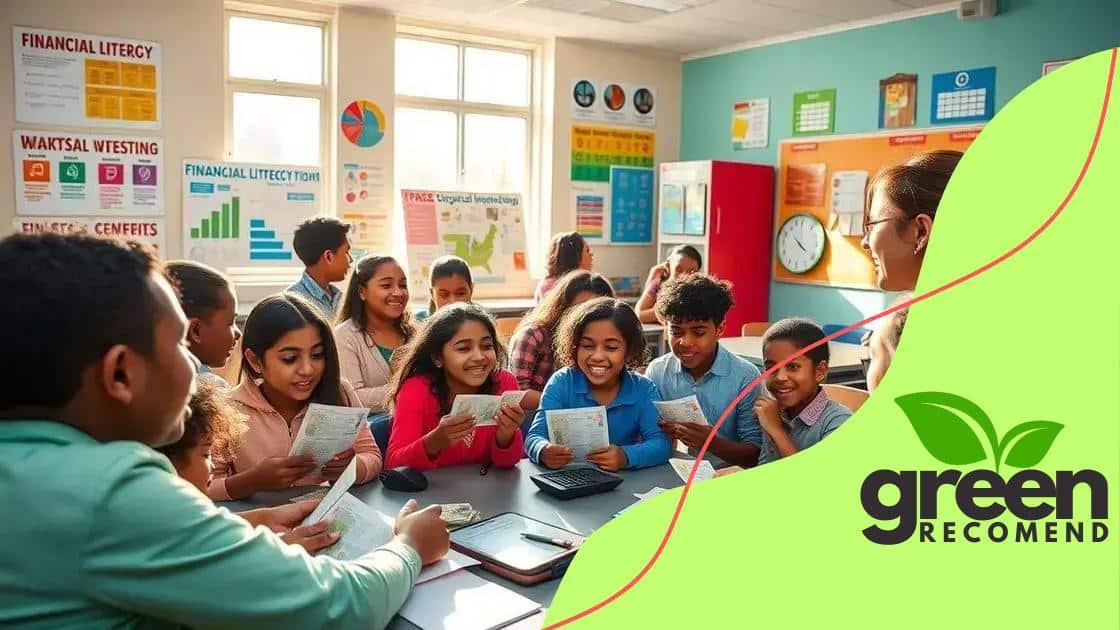Financial literacy programs in K-12 education systems

Financial literacy programs in K-12 education equip students with essential money management skills, improving their decision-making abilities and academic performance while preparing them for a financially responsible future.
Financial literacy programs in K-12 education systems play a crucial role in shaping the financial competence of young learners. Have you ever wondered how these programs can set the foundation for responsible money management later in life? Let’s dive into the benefits and challenges they present.
Understanding financial literacy in schools
Understanding financial literacy in schools is essential for equipping students with the knowledge they need to navigate their financial futures. As money management becomes increasingly crucial in today’s world, schools must prioritize teaching these skills. This education empowers students to make informed choices regarding saving, spending, and investing.
The Basics of Financial Literacy
Financial literacy encompasses several key concepts that every student should learn. It includes understanding how money works, the importance of budgeting, and the benefits of saving early. By grasping these foundational ideas, students can build confidence in handling their finances.
- Understanding the value of money
- Learning to budget effectively
- Recognizing the importance of saving
- Exploring different banking options
Moreover, by being financially literate, students gain the ability to avoid common pitfalls such as debt accumulation and overspending. As education systems recognize the necessity of these skills, many are integrating financial literacy into their curricula more comprehensively.
The Role of Teachers and Curriculum
Teachers play a pivotal role in fostering financial literacy. They need training to ensure they can deliver this education confidently. Integrated lessons that connect math and real-life financial situations can make learning about finance more engaging.
Additionally, schools are starting to adopt financial literacy programs that offer structured guidelines. These programs often include interactive activities, simulations, and practical projects that prepare students for real-world financial situations.
With lessons that involve actual budgeting exercises and discussions around saving for college, students can relate better to the material. This practical approach helps ensure that financial concepts are not just theoretical but applicable to everyday life.
In conclusion, by improving students’ understanding of financial literacy, schools are doing more than just teaching; they are preparing future generations for a successful financial journey. Investing in this education is a necessity for building a financially responsible society.
Importance of financial literacy programs
The importance of financial literacy programs in education cannot be overstated. These programs provide students with the essential skills needed to manage their money wisely, which is crucial for their future financial well-being. In today’s economy, understanding how to handle finances is as important as academic subjects.
Benefits of Financial Literacy
One of the main reasons these programs are vital is the range of benefits they offer to students. By learning about financial management, students can make informed decisions that positively impact their lives.
- Better money management skills
- Increased ability to save and invest
- Decreased likelihood of falling into debt
- Greater awareness of financial resources
Additionally, these programs help reduce anxiety related to financial matters. When students are equipped with knowledge, they feel more confident in handling their finances. This confidence can lead to healthier financial habits during their adult lives.
Real-World Application
Financial literacy programs also emphasize real-world applications of financial concepts. Students participate in activities that simulate real-life scenarios, such as budgeting for a project or saving for a goal. These experiences bridge the gap between theory and practice, making learning engaging and relevant.
Moreover, students learn the significance of setting financial goals and how to achieve them. They begin to understand the value of making informed choices about spending, investing, and saving, which leads to long-term financial success.
Teachers and parents can support these programs by encouraging discussions about money at home. Open conversations regarding personal finance contribute to a more comprehensive understanding of financial literacy.
In conclusion, integrating financial literacy programs into K-12 education equips students with skills they need for a successful financial future. The earlier they learn, the more prepared they will be to face financial challenges as adults.
How these programs can improve student outcomes

Financial literacy programs have the potential to significantly improve student outcomes in various ways. By providing young learners with important financial skills, schools can help them become more responsible and informed adults. These programs not only teach students how to manage their money but also prepare them to face financial challenges in the future.
Enhancing Decision-Making Skills
One key advantage of financial literacy programs is that they enhance students’ decision-making skills. When students learn about budgeting, saving, and investing, they are better equipped to make informed decisions. This foundational knowledge encourages them to weigh options carefully before making financial choices.
- Understanding the concept of opportunity cost
- Evaluating pros and cons of spending
- Identifying effective savings strategies
- Recognizing the value of setting financial goals
Moreover, these programs foster critical thinking. Students learn to analyze financial situations and consider the long-term effects of their financial choices. This analytical approach is invaluable, as it contributes to their overall cognitive development.
Improving Academic Performance
Financial literacy is not just about money; it also correlates with improved academic performance. Studies have shown that students who participate in financial education often exhibit higher engagement in school. Understanding their financial futures may motivate them to focus more on their studies.
Additionally, students who grasp financial concepts tend to perform better in related subjects such as mathematics. The skills they gain in financial literacy align with real-world applications of math, further enhancing their learning experiences.
Furthermore, instilling a sense of responsibility regarding finances helps create more disciplined students. As they learn to manage their personal finances, they may also become more organized and goal-oriented in their academic pursuits.
Through a well-structured financial literacy program, schools can bridge the gap between academic success and personal finance skills. Teaching these important lessons not only prepares students for their futures but also empowers them to make choices that lead to healthier financial lives.
Challenges in implementing financial literacy
Implementing financial literacy programs in schools comes with several challenges that educators and administrators must navigate. These obstacles can hinder the effectiveness of these vital programs. Understanding these issues is the first step towards creating solutions.
Limited Resources
One major challenge is the limitation of resources, including funding and materials. Many schools operate on tight budgets, making it difficult to allocate funds for new programs. Without proper financial resources, educators may struggle to provide comprehensive financial education.
- Insufficient training for teachers
- Lack of engaging educational materials
- Limited access to financial professionals as guest speakers
- Difficulties in integrating programs into existing curricula
Additionally, teachers may not have enough training in financial literacy to feel confident teaching the subject. This lack of training can lead to inconsistent delivery of the content, which can negatively impact student understanding.
Awareness and Buy-In
A further challenge involves raising awareness and gaining buy-in from stakeholders. Parents, educators, and administrators must recognize the importance of financial literacy. Without their support, implementing these programs can be a daunting task.
Many may not fully understand the value of financial education or may prioritize other subjects they deem more critical. Overcoming this mindset requires effective communication about the necessity of equipping students with life skills.
There might also be resistance to change within existing school structures. Some educators may feel overwhelmed by the prospect of adding another subject to the already crowded curriculum. This apprehension needs to be addressed through clear communication and support from school leaders.
Finally, creating a comprehensive and engaging curriculum can be particularly challenging. Developing lessons that capture students’ attention while covering essential financial principles is crucial. Meeting the needs of diverse learners can also complicate program development.
Future trends in financial literacy education
Future trends in financial literacy education indicate a shift towards more interactive and technology-driven approaches. As we look ahead, it is clear that educational methodologies will evolve to engage students more effectively. These changes will help ensure that financial literacy remains relevant and impactful for future generations.
Emphasis on Technology
One prominent trend is the increasing integration of technology in financial literacy programs. Schools are beginning to adopt digital platforms that provide interactive learning experiences. These tools can help students understand complex concepts through gamification and simulations.
- Online budgeting tools that let students practice managing money
- Mobile apps that teach saving and investment strategies
- Virtual simulations that mimic real-life financial decisions
- Interactive webinars hosted by financial experts
This technological approach not only makes learning more fun but also mirrors the digital landscape that students will navigate in the real world.
Personalization of Learning Experiences
Another trend is the personalization of financial literacy education. Educators are recognizing that each student has unique financial needs and interests. By tailoring lessons to individual students, schools can provide more relevant and engaging content.
For example, some programs may focus on specific topics such as student loans, credit scores, or investing, based on students’ interests and future aspirations. This targeted approach can lead to better engagement and retention of information.
As these trends continue to develop, collaboration between schools, financial institutions, and community organizations will play a crucial role. Partnerships can provide resources, expert knowledge, and real-world connections that enhance the effectiveness of financial literacy education.
With these innovations, the goal remains clear: to prepare students for a financially responsible future, equipping them with the tools and knowledge they need to succeed.
In conclusion, implementing financial literacy programs in K-12 education is essential for preparing students for a successful financial future. These programs offer numerous benefits, such as improved decision-making skills and better academic performance. By addressing challenges like resource limitations and raising awareness among stakeholders, schools can create effective, engaging financial education. Looking ahead, embracing technology and personalizing learning experiences will help make financial literacy more relevant and accessible for all students. Ultimately, equipping young learners with these crucial skills will lead to a generation of financially responsible adults.
FAQ – Frequently Asked Questions about Financial Literacy Programs
Why are financial literacy programs important in schools?
Financial literacy programs help students learn essential money management skills, preparing them for a successful financial future.
What challenges do schools face when implementing these programs?
Schools often face resource limitations, lack of training for teachers, and the need for support from parents and the community.
How can technology enhance financial literacy education?
Technology can provide interactive learning experiences through apps and online tools, making financial concepts more engaging for students.
What trends are shaping the future of financial literacy education?
Future trends include the emphasis on technology integration, personalized learning experiences, and collaboration with financial institutions.





